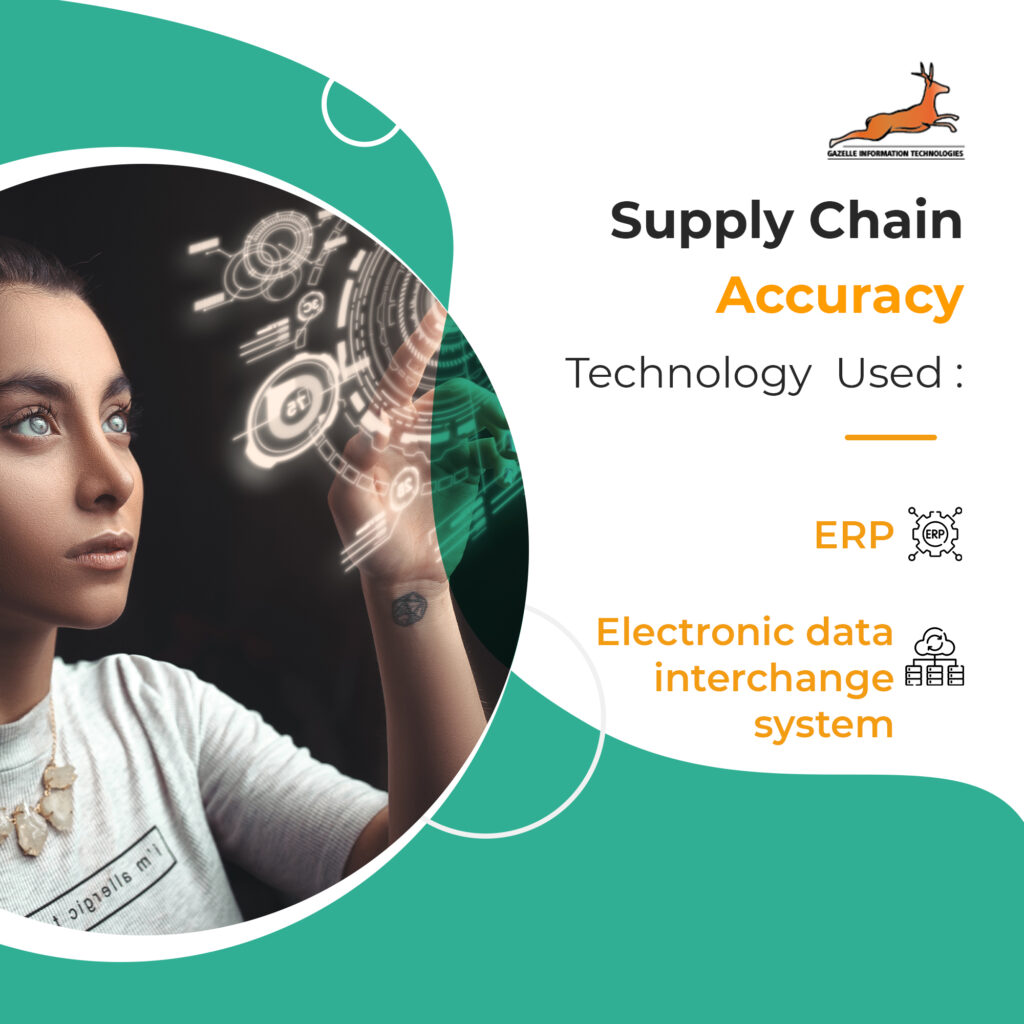Supply Chain Accuracy
Transformation Spectrum

- PAST
- PRESENT
- FUTURE
Technology Used:
- Paper works
- Spread sheets
- Gut feelings
Method Used:
- Leave rooms for inaccurate data
 Technology Used:
Technology Used:
- ERP
- Electronic data interchange system
Method Used:
- Agile method
- Continuous flow method
- Custom configured model
- Effective chain model
- Fast chain model
- Flexible model
- Supply chain operation reference
Technology to be used-
- Cognitive learning
- Machine learning
- IOT
Method to be used:
- Automation
- Real time processing
- Audit accuracy
Past
1. Technologies Used
Paper works –
- The supply chain relies on physical documents.
- Shipment details are communicated among shippers, carriers, and retailers.
Spreadsheets –
- A spreadsheet is a tool that is used to store, manipulate and analyze data.
- Spreadsheets allow analysis from many different perspectives.
- Can be modified and enhanced to reflect new situations and options.
Gut Feelings –
- It depends on the timing, whether it’s a fast-thinking decision or a slow-thinking decision.
- Intuition plays an important role in a decision that needs to be made in the next few seconds during a negotiation.
2. Method Used
Leave rooms for accurate data –
- An accurate data entry yields good results making the supply chain operation successful.
- Provides the foundation on which supply chain processes execute transactions and managers make decisions.
Present
1. Technologies Used
ERP –
- Planning software brings the important functions of the supply chain into the data stream with the ERP.
- Improves forecasting and drives consensus as well as builds confidence.
Electronic data interchange system –
- Standardizes transactions with suppliers reducing the risk of miscommunication, human error, incorrect shipments and other mistakes.
- EDI can help eliminate procurement errors and clarify inventory status information throughout the supply chain.
2. Methods Used
Agile method –
- Responsiveness, competency, flexibility, and quickness to manage how well a supply chain entity operates on a daily basis.
- Measuring metrics assessing the level of customer service (i.e., speed, reliability, and quality of service), and the cost to serve.
Continuous flow method –
- Relies on supply and demand stability.
- Processes are scheduled in such a way as to ensure a steady and continuous flow of information and products.
Custom configured model –
- A combination of the agile and continuous flow models.
- An ideal in scenarios where multiple product configurations are required.
Effective chain model –
- Management must maximize utilization of machinery and other assets.
- Must maintain high overall equipment efficiency to reduce cost.
Fast chain model –
- Used by businesses that manufacture finished products.
- They deal mainly with extremely trendy products that have a short lifecycle.
Flexible model –
- Adapts to meet the natural flow of your business.
- Makes sure resources are not wasted due to the inability to make immediate changes.
Supply chain operation reference –
- This framework focuses on five areas of the supply chain: plan, source, make, deliver, and return.
- To address, improve, and communicate supply chain management decisions within a company and with suppliers and customers of a company.
Future
1. Technologies Used
Cognitive learning –
Cognitive supply chains analyze all types of data.
- Internal (such as point-of-sale, material inventory, work-in-process, and inbound shipments)
- External (weather forecasts, social sentiment, and market trends).
Machine learning –Its multiple capabilities are essential for business success in providing accurate information and predictions and recognizing patterns.
IoT – By automatically collecting data, IoT systems eliminate human error in data collection and so help improve demand forecasting.
2. Methods followed
Automation – The use of digital technologies to improve efficiencies, connect applications and streamline processes within supply chain operations.
Real-time processing – Logistic activities that track and trace, in real-time, the movement of goods and packages from the suppliers, manufacturers, warehouses, and hubs to the end customer.
Audit Accuracy – Reviews any or all of the activities and processes that an organization follows to deliver products or services to its customers.
Supply Chain Accuracy
The supply chain is the network of all individuals, organizations, resources, and technology involved in the creation and sale of products.
Accuracy benefits the supply chain in many ways including Optimising logistics and ensuring correct storage is met.
The goal of Supply Chain Accuracy
The primary purpose of supply chain accuracy is to fulfill demand, drive customer value, improve responsiveness and build a good network.
The Primary goals should be:
Faster Delivery
Higher Efficiency
Accelerated Cash flow
Planning is one of the most important at the beginning of supply chain to finalise the strategies and put them into place.
Importance of Supply Chain Accuracy
Better collaborations
Improved quality control
Keeping up with demand
Shipping optimization
Reduce overhead cost
Improved risk mitigation
Future of Supply Chain Accuracy
From location-centric to human-centric work design
From real-time analytics to real-time decision execution
From ambitious action to authentic achievement of sustainability
Operational excellence to commercial innovation
Future of technology used for Supply Chain Accuracy
Industry 4.0 technology will play a valuable role in the creation of a smarter, better-connected supply chain network.
Using sensors and ever-improving internet connectivity, companies are collecting data at every checkpoint
Machine learning, artificial intelligence (AI), and advanced analytics help drive automation and deliver insights that promote efficiencies
3D printing allows firms to localize the production of goods closer to customers, allowing for faster turnaround, and greater personalization.
Future of Process used for Supply Chain Accuracy
Optimizing company-owned inventory is quite high, including forecasting to optimize company-owned inventory.
Improve distribution network
Make Supply Chain council aims to give direction and align the supply chain strategy with core goals
Embrace the technology and use technology to improve the supply chain
Focus on forming strategies to build healthy supplier relationship


 Technology Used:
Technology Used: